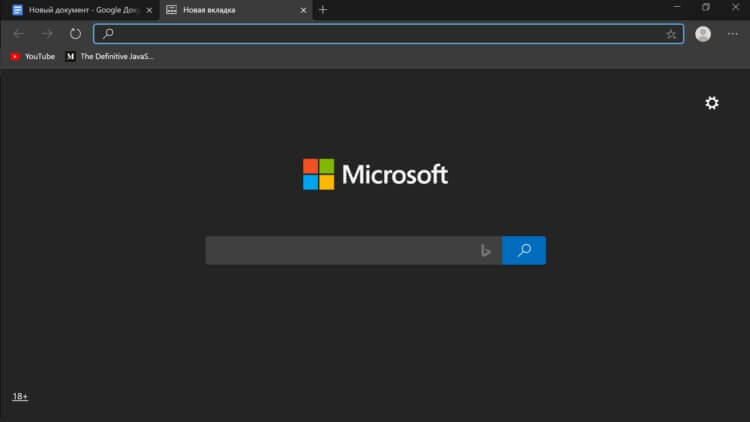The Edge browser based on the Open Source Chromium browser was introduced in mid-January. You can download it at this link. In this article, I propose to consider all its advantages and compare with the main competitor Google Chrome. I have been using Edge for the second day, and this was enough to understand all its features. I’ll say right away that I don’t even think about giving up Edge now, simply because it is better than Google Chrome in all respects. So let's get started.

Edge or Chrome?
I would start my story by saying that you will not feel a very big difference between Chrome and Edge, after all, the fact that they are based on one browser makes itself felt. The new Edge is available to users Windows, MacOS, iOS and Android. The first thing I noticed right away was that Microsoft was particularly concerned with data privacy. In the browser settings, you can activate features that prevent websites from tracking user actions. This is how the company describes the problem:
Websites use trackers to collect information about page views. Websites may use this information to improve the sites and display content such as personalized ads. Some trackers collect and send your data to sites you have not visited.
The browser allows you to block such tracking, offering three degrees: basic, balanced and strict. Basic blocking allows most trackers on all sites, content and ads will be personalized, only known dangerous trackers are blocked. The balanced blocking mode is activated by default and blocks the trackers of sites you have not visited, the content and ads will be less personalized. In strict blocking mode, the browser blocks most trackers from all sites, content, and ads will be minimally personalized.
I decided to focus on strict blocking, since it is it that allows you to completely disable ads on all sites. At the same time, ad blocking works slightly worse than the AdBlock extension, since empty areas remain in place of advertising. But it should be noted that due to the lack of advertising, sites are loaded about 2 times faster. And this feature is built into the browser itself. What is the plus? It's simple. First, there is no need to download third-party solutions from the Internet in the form of extensions. Secondly, each extension is a separate process in the operating system, which consumes about 20-50 megabytes of memory. This can be easily verified by assessing how much RAM Google Chrome consumes with extensions turned on and turned off completely – the difference with a considerable amount will be significant. And dropping AdBlock saves RAM significantly.
Speaking of RAM, I compared Chrome and Edge by launching the same tab with the same website. Edge uses about 20% less RAM. When launching the second tab, the gap is also noticeable – about 15-20%. And, surprisingly, if you do not work with Edge at a certain point in time, in some magical way it reduces RAM consumption by 1.5-2 times, whereas Chrome consumes RAM regardless of whether you use the page or not.
The same goes for the CPU and graphics chip utilization. Edge practically does not consume processor resources, while Chrome sometimes gave up to 5% CPU load for two running pages.
Another advantage of Edge, I would call the reading mode, by analogy with Safari. You can customize the background, font, font size, and so on. In addition, read aloud mode with a choice of voice engine is supported. Even Safari cannot offer that.

Edge Browser Reading Mode

Speak text in Edge
I also liked the fact that you can flexibly customize the main screen by removing unnecessary MSN news feed and other elements. Now my browser is clean and nice:

Home Screen Microsoft Edge
As you might have guessed, the browser is using an account Microsoft. And if you are already logged into the system, it will recognize it automatically. The account capabilities Microsoft are the same as Chrome offers for data syncing.
Edge supports a dark theme out of the box, and it looks just as cool as it does in Chrome. Overall, the Edge design is perfect. It adapts better to increasing the size of the system font, in my opinion, it has smoother and nicer animations. In addition, for web developers, Edge offers a 3D View for viewing z-index elements. Let's discuss this feature in Telegram.
Output
I've tried many browsers. Firefox, Edge Chromium, Google Chrome, Yandex Browser, Opera, Brave. And while my choice is in favor of Edge based on Chromium. Yandex and Opera have a lot of unnecessary functionality, unnecessary integrations and other garbage. Yandex may do a better job of conserving battery power, but over the past couple of years, such integrations with services have made it seem overloaded and inconvenient. By the way, the same applies to the Yandex search engine, the main screen of which is overloaded with services. The same problem with Opera. Brave is not bad due to the built-in ad blocking tools, but the main screen does not have flexible settings, Firefox is not Chromium, which can already be called a minus, but Chrome itself, as you noticed, loses to Edge.
What browser are you using and are you ready to switch to Edge right now? Share your opinion in the comments.
